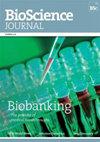Relationships between body mass index, ultrasound measurements and, internal body fat depots in pelibuey sheep
IF 0.6
4区 农林科学
Q3 AGRICULTURE, MULTIDISCIPLINARY
引用次数: 4
Abstract
The objective of this study was to evaluate the relationship between body mass index (BMI), ultrasound measurements (USM), and internal fat (IF) in hair sheep. The BMI and USM were determined 24 hours before laughter in 35 animals finished in intensive fattening. At slaughter, the IF (inner adipose tissue) was dissected, weighed, and grouped as mesenteric, omental, or perirenal fat; these three depots were summed to obtain their total weight. The relationship of the variables was evaluated through Pearson's correlation coefficient (r) using the CORR procedure and by regression models using the REG procedure of SAS ver. 9.3. The IF and BMI presented r= 0.75 (P <.0001), while the IF and USM presented an r that varied from 0.70 to 0.80 (P <.0001). Among the internal fat deposits, the perirenal was the one that presented minor correlation coefficients with BMI (r = 0.55), subcutaneous fat thickness (0.55), and thoracic Longissimus dorsi area) (r = 0.33), and for this, the last correlation was not significant (P>0.05). The regression equation between IF and BMI had a coefficient of determination (r2) of 0.67 (P <.0001). The inclusion of the subcutaneous fat thickness together with the BMI improved the r2 with a range of 0.77. The BMI and the subcutaneous fat thickness could be used to predict the weight of the internal fat in hair sheep.佩利布伊羊体重指数、超声测量与体内脂肪库的关系
本研究旨在探讨毛羊体重指数(BMI)、超声测量值(USM)与体内脂肪(IF)之间的关系。在35只完成高强度增肥的动物笑前24小时测定BMI和USM。屠宰时,将IF(内部脂肪组织)解剖、称重,并将其分为肠系膜、网膜或肾周脂肪;将这三个仓库的总重量加起来,得到它们的总重量。采用CORR方法通过Pearson相关系数(r)和SAS ver的REG方法通过回归模型来评价变量之间的关系。9.3. IF和BMI r= 0.75 (P < 0.05)。IF与BMI的回归方程的决定系数(r2)为0.67 (P < 0.0001)。纳入皮下脂肪厚度和BMI可改善r2,范围为0.77。体重指数和皮下脂肪厚度可以用来预测毛羊体内脂肪的重量。
本文章由计算机程序翻译,如有差异,请以英文原文为准。
求助全文
约1分钟内获得全文
求助全文
来源期刊

Bioscience Journal
Agricultural and Biological Sciences-General Agricultural and Biological Sciences
CiteScore
1.00
自引率
0.00%
发文量
90
审稿时长
48 weeks
期刊介绍:
The Bioscience Journal is an interdisciplinary electronic journal that publishes scientific articles in the areas of Agricultural Sciences, Biological Sciences and Health Sciences. Its mission is to disseminate new knowledge while contributing to the development of science in the country and in the world. The journal is published in a continuous flow, in English. The opinions and concepts expressed in the published articles are the sole responsibility of their authors.
 求助内容:
求助内容: 应助结果提醒方式:
应助结果提醒方式:


